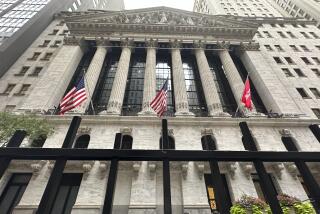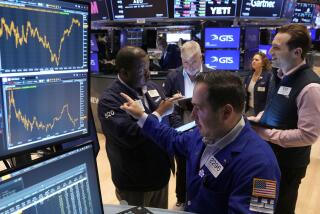Wall Street Gets Early Gift; Dow Up 88 Points : Economy: O.C. stocks fail to follow what analysts call a delayed reaction to the Fed’s discount rate cut.
NEW YORK — Wall Street staged a pre-Christmas rally Monday as the Dow Jones industrial average, defying pessimists, rocketed 88.10 points in a delayed reaction to the Federal Reserve’s sharp cut in the discount rate Friday.
“Call it the Greenspan rally,” said Shearson Lehman Advisers money manager Jeffrey Appelgate, referring to Fed Chairman Alan Greenspan. The Dow finished the day up 3% at 3022.58. Dow transportation stocks climbed an even sharper 4.23%, while utilities gained 1.56%.
“Friday’s bold and aggressive easing move was a marked contrast to the Fed’s previous timid and belated steps to revive the economy,” added David M. Jones, chief economist at Aubrey Lanson & Co., a government securities firm.
Orange County stocks, however, seemed to buck the upward trend. A list of 102 local stocks showed that 28 gained in price Monday, while 31 were down and 43 were unchanged.
Although heartened by Monday’s climb--which was the market’s sixth-biggest point gain ever--analysts were divided on whether it signaled a strengthening of the economy.
“This is one last gasp on the upside,” said Jack Conlon, managing director for equities at Rothschild Inc. “You still have a wide open question as to the existence of a recovery, and, if it does exist, to the magnitude of it.”
But Robert Kahan, trading chief at Montgomery Securities in San Francisco, called the move “very impressive. . . . The rise was much too orderly to be attributable just to short covering or program trading, though both were factors.”
The central bank slashed its discount rate--the rate offered to banks--a full percentage point Friday, to 3.5%, its lowest point in 27 years. Although the Dow climbed 20.12 points in response on Friday, traders said the market’s performance was muddied because the quarterly expiration of certain futures and options caused many investors to stay away. Such expirations often result in volatile trading.
Lower interest rates are good for stocks, because they help corporate earnings and make stocks more attractive investments compared to bonds, certificates of deposit or money-market instruments.
Bond prices also rallied Monday, as the price of the government’s 30-year bond rose and its yield fell to the lowest level in nearly five years.
“People in the fixed-income market generally are optimistic, expecting that the Fed is intent on stimulating the economy,” said Michael Moran, chief economist at Daiwa Securities America Inc.
Monday’s follow-through rally was led by industrial stocks, many of which had been beaten down on recession fears. Alcoa soared $2.625 to $62, International Paper rocketed $4.375 to $67.50, Boeing jumped $2.625 to $46.125 and Caterpillar gained $2.375 to $41.50.
Among Orange County company stocks, construction and engineering giant Fluor Corp.’s shares rose $3.125 to $43. William J. Livingston, an analyst at Merrill Lynch Research in Newport Beach, said construction stocks have surged in anticipation of increased government spending on public works projects in 1992.
Shares of PacifiCare Health Systems, a Cypress health-maintenance organization, rose $3.25 to $38.75. Another health care-related stock, Hycor Biomedical, a Garden Grove biotechnology company, was up 50 cents to $6.125. Personal computer maker AST Research in Irvine fell $1 to $14.50.
Phil Smyth, an analyst at Birinyi Associates in New York, estimated that computer-driven program trading accounted for about one-quarter of Monday’s gain.
Advancing stocks outpaced decliners, with 1,411 up, 421 down and 386 unchanged. Big Board volume was 229.18 million shares, down from 318.42 on Friday.
Although analysts were pleased by Monday’s rally, many were quick to temper assessments, citing mitigating factors that led to the Dow’s jump. “You have to qualify all your judgments by the fact that this was a semi-holiday session,” said Thomas F. Ryan Jr., director of equity trading at Kidder, Peabody & Co.
“There are fewer players in the market, and much less liquidity,” Ryan added. As a result, he said, “though Monday’s advance was encouraging, I wouldn’t bet the ranch on it.”
“It’s one of those mystery days,” added Oppenheimer & Co. chief strategist Michael Metz. “It seems to represent some sort of shift in psychology about the prospects for recovery (and) is especially impressive given it’s a semi-holiday week.”
But the market’s behavior was no mystery to Mary Farrell, a PaineWebber Inc. investment strategist. “Current interest rates are simply unacceptable to average investors,” she said, so they are turning to stocks in their quest for double-digit returns.
Jones, however, cautioned that investors betting on a quick economic turnaround could be setting themselves up for a big disappointment. “With slow income growth, heavy debt burdens and declining net worths and real estate values, it’s going to take a lot to motivate consumers to buy.”
The market was also helped by the traditional “Christmas rally.”
“You have a seasonal bias that really takes hold at year end, where the last week or so the market has an upside bias 80% of the time,” said Joseph Barthel, a market analyst at Fahnestock & Co.
Analysts said buyers were focused on companies that are first to benefit from an economic recovery--such as transportation companies.
“You have the economically sensitive stocks up sharply,” said Don Hays of Wheat First Securities. “There’s no index more economically sensitive than transportation.”
The Treasury’s bellwether 30-year bond gained three quarters of a point, or $7.50 per $1,000 in face amount. Its yield fell to 7.52% from 7.58% late Friday, hitting its lowest level since March 19, 1987.
At the Treasury’s weekly auction Monday, the Treasury sold $10.2 billion in three-month bills at an average discount of 3.75%--the lowest since they sold for 3.70% on May 15, 1972.
More to Read
Inside the business of entertainment
The Wide Shot brings you news, analysis and insights on everything from streaming wars to production — and what it all means for the future.
You may occasionally receive promotional content from the Los Angeles Times.










